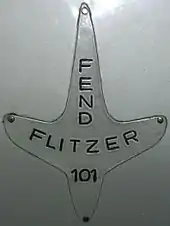
The Fend Flitzer was a three-wheeled invalid carriage designed and built by Fritz Fend. The Flitzer established many of the basic concepts on which Fend's later Messerschmitt Kabinenroller microcars were developed.
Background
In 1948, Fend, a former aeronautical engineer and technical officer in the Luftwaffe,[1] began production of a tricycle invalid carriage in his workshop in Rosenheim, Germany.[2][3][4] The tricycle had a front wheel that was steered by handlebars and powered by a mechanism actuated by pushing back and forth on the handlebars. Shortly afterward, it was offered with a 38 cc (2.3 cu in) Victoria two-stroke proprietary engine normally used for motorizing bicycles.[2]
Fend then designed the Flitzer, a larger, better-enclosed invalid carriage. It was designed from the start to be powered by a gasoline engine. Whereas the earlier tricycle was both steered and powered by a single front wheel, the Flitzer had a pair of front wheels linked to the steering mechanism and a powered rear wheel.[2]
Specifications and development

The Flitzer was made with aluminium panels over a steel frame[2] and was enclosed at the front, sides, and back. It had a hatch at the top that was hinged at the front and tilted forward for the operator to get in.[2] The first version of the Flitzer was open, with a hole and a windshield in the hatch for the operator's head and shoulders to stick through and be protected from the wind. Flitzers made from September 1948 into 1950[3] were powered by a 98 cc (6.0 cu in) Fichtel & Sachs two-stroke engine.[2][3][4] Suspension was by rubber springs loaded in torsion.[2]
In 1950 the engine was changed to a 100 cc (6.1 cu in) Riedel/Imme engine.[2][3][4] By 1951, in response to customer requests for passenger-carrying capability, a scooter-type saddle was placed above the rear enclosure with footrests on either side of the body.[2] A closed version, on which the hatch had an enclosure that covered the operator, was made available. The enclosure included the windshield and side windows.[2][3]
Reception and legacy

About 250 Flitzers had been built when production stopped in 1951. Many of these invalid carriages had been bought by able-bodied individuals seeking basic personal transport.[2] This led Fend to believe that there would be a mass market for a larger, transport-oriented version of the Flitzer.[5] Fend began to design and develop a two-seat vehicle similar in concept to the Flitzer.[3] He also began looking for a manufacturer to mass-produce this vehicle. He came to an agreement with Messerschmitt for them to build Fend vehicles in their factory at Regensburg[3][5] Part of the agreement was that the cars carried the Messerschmitt name, with Fend's new design being designated the Messerschmitt KR175.[3][6]
Notes
References
- Cawthon, Bill (2008-03-01). "Fritz Fend's Marvelous Micro-cars". Promotex Online. Cadabra Corp. Archived from the original on 2011-07-06. Retrieved 23 August 2008.
- Payne, Elvis (2004-05-31). "3-Wheelers.com - Fend". 3-wheelers.com. Archived from the original on 2011-07-07. Retrieved 24 August 2008.
- Wagner, Carl (1973). Vorderman, Don (ed.). ""Ist das nicht ein Kabinenroller?" "Ja! das ist ein Kabinenroller!" Carl Wagner takes off on Messerschmitt". Automobile Quarterly. New York: Automobile Quarterly Inc. 11 (2 – Second quarter): 162–171. LCCN 62-4005.
External links
- Bruce Weiner Microcar Museum - 1950 Fend Flitzer 101
- Fend Flitzer 101 on YouTube – video showing a Fend Flitzer 101 being driven on the road and arriving at a destination.